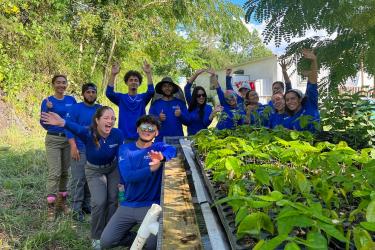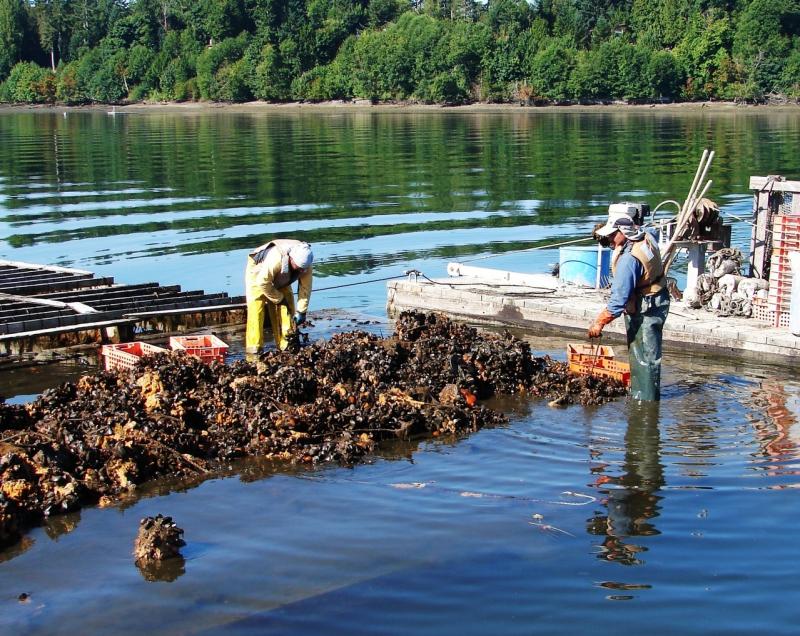Meet your Regional Aquaculture Coordinator
Dr. Bill Walton with the Auburn University Shellfish Laboratory checks the growth of oysters in off-bottom culture systems.
What is Marine Aquaculture?
Marine aquaculture refers to the culturing (i.e., “farming”) of species that live in the ocean. In the U.S., marine aquaculture primarily produces oysters, clams, mussels, shrimp, and salmon as well as lesser amounts of cod, moi, yellowtail, barramundi, seabass, and seabream.
Most marine aquaculture in the U.S. takes place in coastal state waters or on land in ponds or tanks. There is increasing interest in expanding aquaculture to the offshore environment. NOAA defines offshore aquaculture as aquaculture that occurs in federal waters. In the U.S., federal waters begin where state jurisdiction ends and extends out to 200 nautical miles.

In the southeast, researchers are focusing on production techniques for tripletail, a warm water marine species.
Marine Aquaculture in the Southeast
In the southeast region (Gulf of Mexico and South Atlantic states, Puerto Rico and the U.S. Virgin Islands), marine aquaculture focuses on stock enhancement (i.e., the release of juvenile fishes to supplement wild populations), food production, research, and restoration efforts. Species cultured in the region include oysters, clams, shrimp, red drum, almaco jack, spotted seatrout, summer flounder, snook, pompano, black seabass, and algae.
More information on NOAA’s role in marine aquaculture can be found on the Office of Aquaculture website.
Live Rock in the South Atlantic and Gulf of Mexico
NOAA Fisheries issues permits for aquacultured live rock (the growth of corals and sponges for sale in the aquarium trade) in federal waters off the Gulf and South Atlantic coasts of Florida. Permit applications are available for download from the Southeast Regional Office.
Shellfish Aquaculture in the Gulf of Mexico
Shellfish aquaculture is a rapidly growing industry and will continue to increase with seafood demand and an increasing human population. The Gulf states are an important producer of farmed bivalves such as hard clams, oysters, bay scallops, and sunray venus clams. In 2016, the Gulf states produced more shellfish by volume than any other region in the nation.
Learn more about NOAA's shellfish aquaculture work
Offshore Aquaculture in the Gulf of Mexico
Due to a 2018 court ruling, NOAA is not currently issuing permits for aquaculture in federal waters of the Gulf of Mexico, however, NOAA continues to support the development of offshore aquaculture through early engagement and participation in other federal agency permitting processes.
NOAA has collaborated with partner agencies and other experts to create the several guidance documents and site screening tools for offshore aquaculture, some of which are listed below. Other documents including Pre-Application Meeting Guidance, Baseline Environmental Survey Guidance and Interagency Memorandum of Understanding are currently being revised. Please contact Andrew Richard, Regional Aquaculture Coordinator for the NOAA Fisheries Southeast Region for more information at (727) 551-5709. or nmfs.ser.aquaculture@noaa.gov.
Basis-of-Design Technical Guidance for Offshore Aquaculture Installations in the Gulf of Mexico (PDF 27 pages, finalized April 2019)
A Guide to the Permitting and Authorization Process for Aquaculture in U.S. Federal Waters of the Gulf of Mexico (PDF 22 pages)
Site screening tools:
NOAA Aquaculture Program Webpage
Andrew Richard is NOAA’s Southeast Regional Aquaculture Coordinator. For more information, contact Andrew at 727-551-5709 or via nmfs.ser.aquaculture@noaa.gov.



